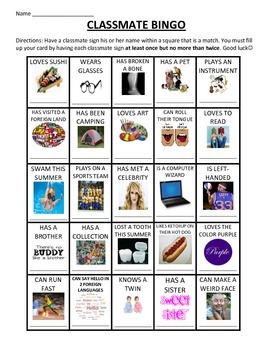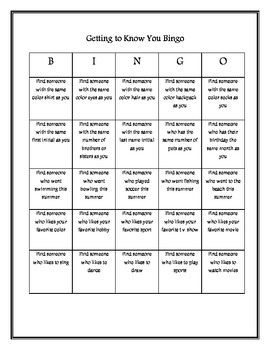


Split the team into groups and provide them with a list of items or landmarks to find within a limited amount of time. Not only do they encourage collaboration, but they also help first-year students familiarize themselves with campus. Whoever gets to Bingo first is the winner.Īlso, an icebreaker classic, scavenger hunts are an excellent activity for orientation. Students are given a set amount of time to find a classmate for which the statement holds true. The statement should be broad and non-intrusive (for e.g., ‘has an older brother’ or ‘is a freshman’). Provide each student with a piece of paper containing a grid in which each square contains a statement. It is an excellent way to get students to interact and get to know each other. People Bingo is a good game to play for individuals meeting each other for the first time. Have people share with the group where they were born and one fun fact about their birthplace. Place a map and pins at the front of the room (please note that this can also be done in a virtual environment) and ask people to place a pin where they were born. It also gives people the opportunity to share a little bit about their background and build rapport. Give students no more than two minutes to share their memory and get ready to laugh.Ī Birth Map enables participants to visualize the diversity in the room. What better way to get people to loosen up than to have them share their Most Embarrassing Moment?Įach student will take turns sharing this moment with the group. Fellow participants will then have to guess which of these “facts” is a lie. However, one of these “facts” will not be true. Please note that, depending on the number of participants, the group can be split into smaller groups for efficiency’s sake.Īn icebreaker classic, Two Truths and a Lie is a fun way to help students get to know each other.Įach participant tells the group three “facts” about themselves. To start meetings or certain activities off on a different note, we have compiled a list of 10 fun icebreakers. This often leads to meetings being dominated by the same people, contributing to group think. The more introverted personalities may not feel comfortable stepping out of the woodwork. It also doesn’t encourage everyone to have a voice.

It also gets members to connect on a personal level and build rapport.Īsking "How is everyone?" at the beginning of a meeting or diving straight into a round robin doesn’t stimulate connection or bonding. Hosting a variety of fun and engaging icebreakers is a great way to do this. It is critical for student leaders to make participants feel welcome and at ease. This may especially be true for first-year students or those attending a student organization or club meeting for the first time. Building relationships with fellow students, professors, tutors, and mentors is a key part of the college experience.īeing in a new environment and getting to know new people can, however, feel overwhelming and intimidating. Further, icebreakers stimulate a sense of belonging among participants.įor students, this feeling of belonging is a key predictor of engagement, retention, and overall success. As a social activity, they help people get to know each other and bond on a personal level. Icebreakers provide the framework to take a break and help disperse anxiety. They also are an excellent way to simply have fun! They get people to connect and team up in a safe environment. They offer participants a moment to pause and relax in a busy day.


 0 kommentar(er)
0 kommentar(er)
